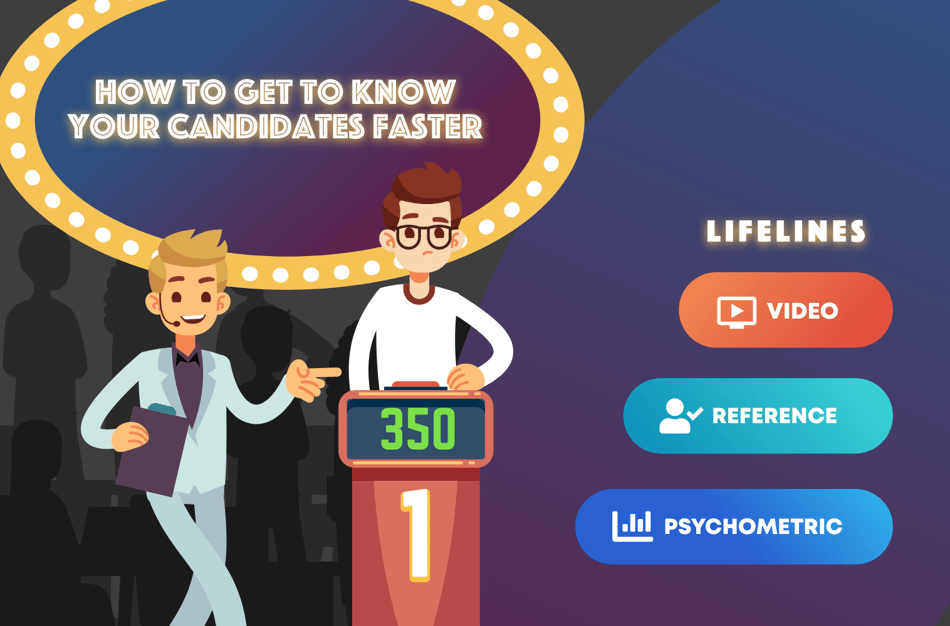Use Your ‘Recruitment Lifelines’
When recruiting, the stakes are high, money is on the line, and the clock is ticking. Ultimately, recruiters have the difficult task of getting well enough acquainted with candidates from two A4 pages and maybe a few minutes of interview time to make an informed decision.
However, with the cost of recruitment averaging around $18 982 per new employee, companies should be exhausting their ‘recruitment lifelines’ to ensure they are making an informed hiring choice.
Now, what exactly do I mean by ‘recruitment lifelines’ you ask? Well, I am referring to tools recruiters can utilise in their hiring process to ensure they are getting to know their candidates in the most effective and efficient capacity possible.
So, let’s go through what each of these ‘recruitment lifelines’ are.
Automated Reference Checks
These days people don’t even buy a shirt online without consulting reviews. So, why would a company invest in a new employee without consulting someone who has worked with them before?
I believe in finding out as much as possible before investing in anything. So what shocks me is that even when making the huge investment of hiring a new employee, some companies do not perform any reference checks.
In the past, reference checking could be a long and tedious task, but today automated reference checking software completely takes the hassle out of this process. So, there is no reason to not consult with your candidate’s referees.
What’s more, failing to conduct adequate pre-employment checks such as reference checks could be leaving your company open to negligence claims. A famous example of this is when the Quakers Hill Nursing Home failed to conduct any reference checks on a newly hired staff member, who soon after being hired, set fire to the facility, where 14 people died as a result back in 2011. If they had conducted reference checks, they would have discovered the nurse in question had been suspended and investigated at his two previous jobs.
This is a reminder of the importance of conducting adequate pre-employment checks, such as reference checks. Not only will they help you make a more informed decision, but they will also help avoid situations like the one above.
Video Interviews
Despite their rise in use during the pandemic, video interviews are still not being used to their full potential by many recruiters. Often they are merely used instead of traditional face-to-face interviews. Though, only using video interviews in this way limits the potential benefits of the tool.
One-way video interviews give recruiters the unprecedented opportunity to get acquainted with candidates earlier in the recruitment process. Unlike standard face-to-face interviews, one-way video interviews can be used as early as the application stage. Proving HR with insight that traditional interview methods simply cannot.
The way they work is candidates have to record their responses to a series of predetermined interview-style questions, which are later reviewed by HR. In the set-up for a video interview, recruiters can set time limits on answers which helps ensure this ‘lifeline’ remains a time-efficient insight tool.
One major insight that one-way video interviews can shed light on is a candidate’s soft skills. These skills are next to impossible to showcase on paper, and candidates with amazing soft skills may be overlooked in a traditional resume application process. With one-way video interviews, candidates can get their foot in the door, showing off skills that can’t be effectively showcased on paper.
So, despite grievances some may have with video interviews, you cannot deny that they hold huge potential insight for recruiters.
Psychometric Talent Assessments
The final ‘recruitment lifeline’ that I will discuss is psychometric talent assessments. These assessments use a combination of psychology and technology to provide recruiters with an accurate, unbiased assessment of candidates.
The AI technology used to analyse these psychometric talent assessments is designed to look for verbal and non-verbal cues in your candidate’s responses. These cues include word choice, sentence structure, tone, and pitch are all used to make the final assessment of each candidate. The vetted database and algorithms used to conduct the assessment ensure there is no unfair bias affecting the results.
Once the assessment has been completed, recruiters are given a clear report of candidates’ soft skills, emotional insight and personality traits. This can be easily shared amongst stakeholders alongside the video interviews on which the assessment was based.
This is an efficient way to get an unbiased and accurate second opinion of candidates in a matter of minutes.
Final Thoughts
Every professional needs the right tools to do their job efficiently. A builder needs their hammer, a plumber needs their wrench, and recruiters need their ‘recruitment lifelines’.
So recruiters, don’t be afraid to get a new perspective on your candidates – it can never hurt to have a bigger and better picture to work with.





Blog comments